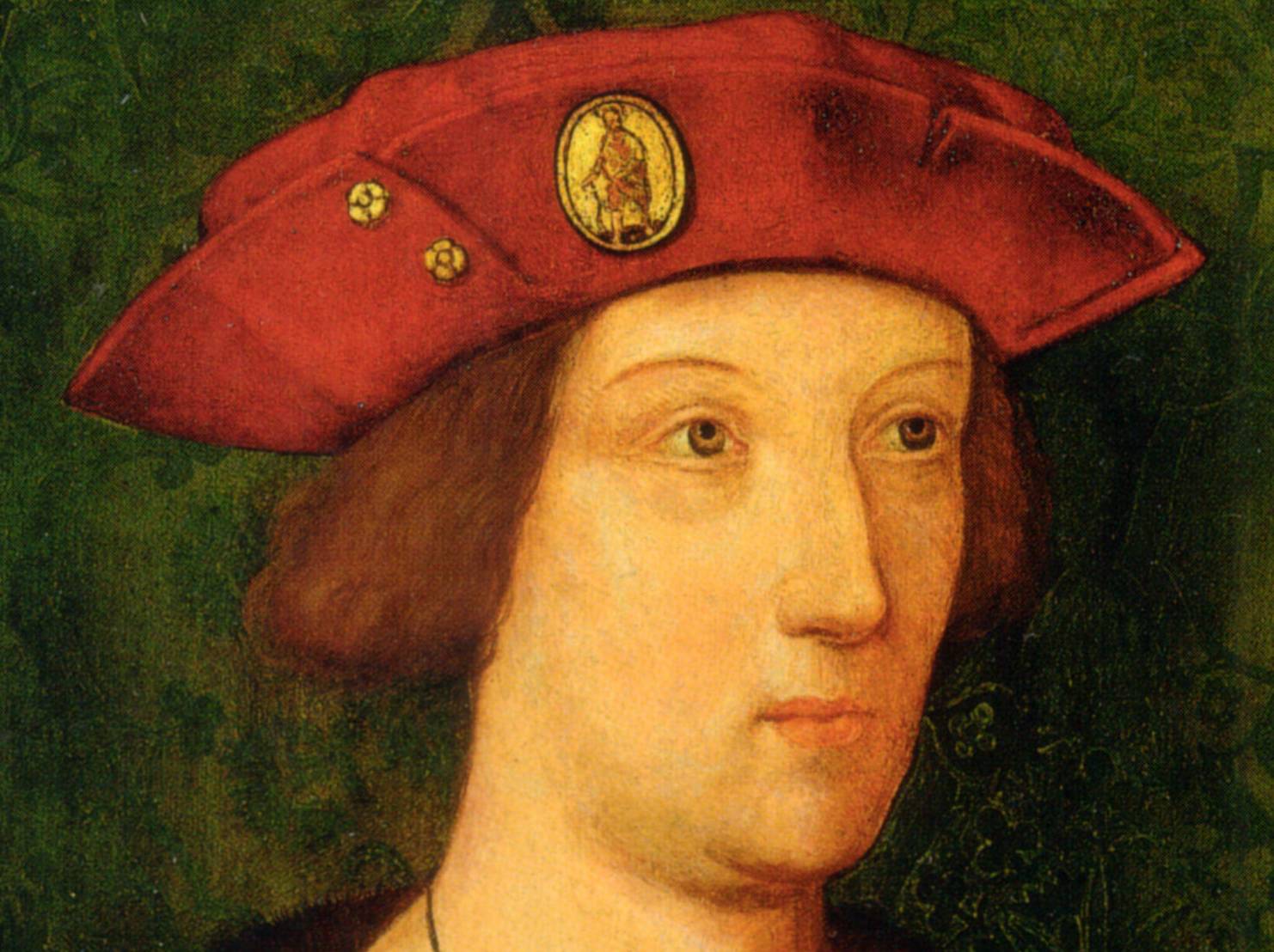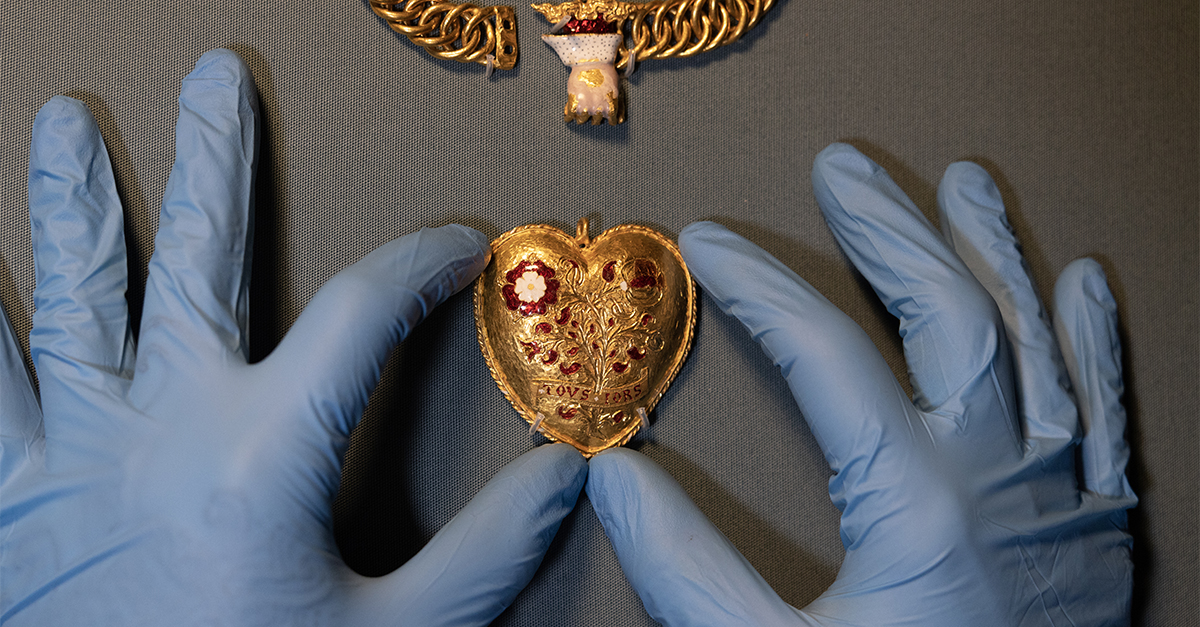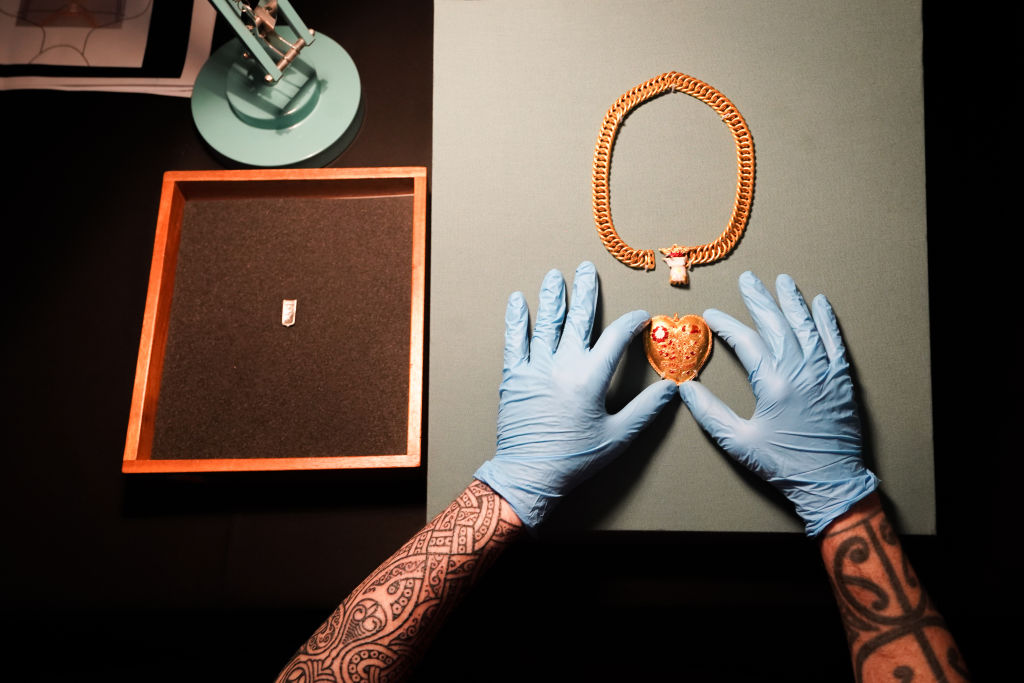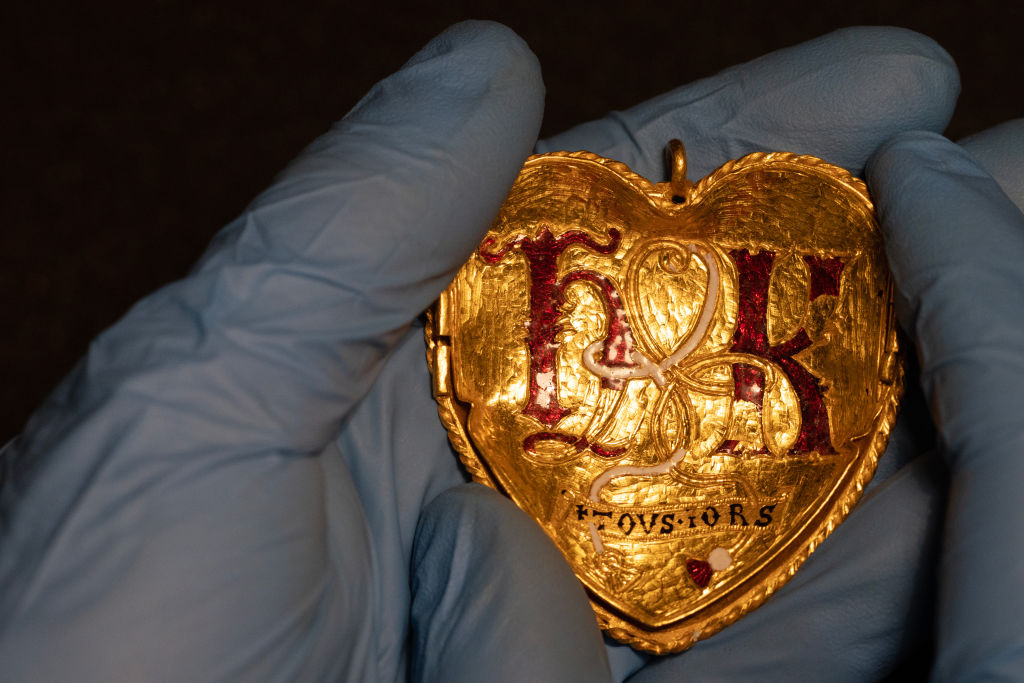Finding Treasure
It stands to reason that most people who pick up metal detectors expect to maybe make back their investment in coins or lost jewelry. Maybe, they’ll reunite a lost wedding ring with an ever-so-grateful owner, if they’re lucky.
But in 2019, an English man got much more than he bargained for when he found an absolutely stunning lost treasure that belonged to one of the Tudor era’s most remarkable figures.

A Visit To Warwickshire
35-year-old Charlie Clarke owns a café in Birmingham, and way back in 2019, he purchased a metal detector on a whim. A few months later, reeling from the loss of his beloved dog, Clarke went to visit a friend in picturesque Warwickshire. He decided to bring the metal detector on a whim—not knowing it would change everything.
A New Hobby
Clarke took the metal detector with him, which he’d only owned for about six months, on a stroll of his friend’s property, not expecting to find much more than empty soda cans. When it started beeping—loudly—he knew it was something worth digging for. And so, he began to dig.
An Unusual Find
After getting about a foot down, Clarke was met with the surprise of a lifetime. It was a large, heart-shaped pendant, with floral designs and jewels on the front, on a chunky gold chain. The piece was so extravagant, it looked like something you might find in the props department for a high school play. But it wasn’t.
Shriek Worthy
Clarke felt how heavy it was, and he knew that he had something special on his hands. When he realized that the piece might be real, he said he “shriek(ed) like a little schoolgirl, to be honest”. And he only got more excited after that.
The Symbols
As it turned out, the friend that Clarke was visiting was something of a Tudor history buff. They immediately recognized the symbols on the front of a pendant—a pomegranate bush, and a double-headed rose—as relating to one of the most compelling royal couples in history: Katherine of Aragon and Henry VIII.
The Initials
The bush was a popular emblem for Katherine, while the double-headed rose represented the Tudors. Turning the pendant over only reinforced their suspicions. On the back were the letters H & K, engraved in Lombardic script, and connected with a ribbon, for Henry and Katherine.
What Do You Do When You Find A Treasure?
Clarke was soon in the middle of a situation few Brits—or anyone anywhere, really—have to face. What to do with a potentially priceless piece of history? Well, the UK government had something to say in the matter.
Mandated Reporting
Clarke, in this situation, was encouraged by something called the Portable Antiquities Scheme to report what he had found, thereby giving museums a chance to bid on the item instead of having them disappear into the private market. Any fee would then be split between the person who found it and the owner of the land it was found on.

History's most fascinating stories and darkest secrets, delivered to your inbox daily.
Finders Keepers
The Portable Antiquities Scheme in Britain was created relatively recently—only 26 years ago. Despite this mandated reporting, very few treasures of this caliber have been reported in the period since the law came into effect. Items from the Renaissance period are extremely rare, and some historians estimated that nothing of this quality has been found in England in more than a century.
So what makes it so special?
A Piece Of History
You don’t need to be an expert to surmise that the pendant is special—you just need to look at it. It’s breathtaking. But upon further inspection, experts found some peculiarities that truly set it apart.
The Pendant’s Journey
Clarke first brought the pendant to an expert in Birmingham, who was shocked at the find. The pendant then went to the British Museum to be examined by experts there. Their reactions were similar. But now they were faced with a difficult task—figuring out if it really was an artifact from the Tudor era, or simply a well-made replica.
The Examinations
After thorough testing, experts at the British Museum were able to ascertain that the pendant was about 500 years old—putting it, yes, smack dab in the middle of Henry VIII’s marriage to Katherine of Aragon. But when they examined it further, they realized it was unlike anything they’d ever seen before.
The Ownership
Considering its age—and the initials—it would be easy upon first glance to believe that the pendant may actually have belonged to Katherine, and perhaps might have been a gift from Henry VIII. That would make it an especially interesting historical artifact, given their fraught history.
The Tudors
When it comes to specific periods in English history, the Tudors have always been a point of fascination for people, and who can blame them? The Wars of the Roses were a particularly fascinating period of history, which was subsequently followed by Henry VIII’s reign, in all its complicated, scandalous, tempestuous glory.
It was a true turning point for England.
 Hans Holbein the Younger, Wikimedia Commons
Hans Holbein the Younger, Wikimedia Commons
Henry VIII
Henry VIII was never supposed to be king. That fate was destined—or so their parents thought—for his brother Arthur, who was five years older. As they grew up, Henry watched as his parents went through prospective brides for Arthur. The woman they chose would make history.
 Joos van Cleve, Wikimedia Commons
Joos van Cleve, Wikimedia Commons
Katherine Of Aragon
Katherine of Aragon’s parents were the ultra-powerful King Ferdinand and Queen Isabella of Spain—essentially making her the most eligible bachelorette in Europe. To the Tudors, she seemed like a perfect match for their Arthur—yes, Arthur, not Henry.
They went ahead with planning their wedding…not knowing they were sealing Katherine’s fate.
 Juan de Flandes, Wikimedia Commons
Juan de Flandes, Wikimedia Commons
The (First) Wedding
Though the engagement happened when Katherine was just three years old, the Tudors ever-so-sensibly waited to have the wedding until the pair were a ripe…15 and 16 years old. The ceremony was resplendent, but after it ended, the couple faced a real nightmare.
 All3 Media, The Spanish Princess (2019– 2020)
All3 Media, The Spanish Princess (2019– 2020)
The Bedding Ceremony
The couple were forced to perform a bedding ceremony, which is even more horrific than it sounds. Arthur’s grandmother undressed the teenaged Katherine and put her in bed. Then, Arthur—and his entire wedding party, including musicians—entered the room, and he got into bed with her.
This wasn’t even a common custom at the time—the Tudors just decided to get weird with it.
 Lucas Horenbout, Wikimedia Commons
Lucas Horenbout, Wikimedia Commons
Prince Arthur
As we’ll see, this one night of wedded “bliss” would come back to bite Katherine. But in the meantime, she tried to enjoy her so-called honeymoon period. Unfortunately, it would be short-lived.
 Royal Collection, Wikimedia Commons
Royal Collection, Wikimedia Commons
The Sweating Sickness
After their wedding, Arthur seemed to grow weaker and weaker. He was ill around Christmas, and eventually Katherine caught it too. It seemed to be the fatal “sweating sickness” that was sweeping the area at the time—bad news. Only one of them would make it out alive.
 All3 Media, The Spanish Princess (2019– 2020)
All3 Media, The Spanish Princess (2019– 2020)
Katherine The Widow
Arthur’s sickness got worse until he passed on April 2, 1502. Katherine was a teenaged widow, far from home, with a family she didn’t know. King Henry VII didn’t want to send her back to Spain and return her dowry. So, instead, he suggested she stay—and marry the next man in line for the throne: his son Henry.
 All3 Media, The Spanish Princess (2019– 2020)
All3 Media, The Spanish Princess (2019– 2020)
Henry & Katherine
The union was considered incredibly scandalous, and Henry VII actually had to get special dispensation from the Pope to allow the pair to marry. As part of it, they forced Katherine to make a disturbing confession.
 All3 Media, The Spanish Princess (2019– 2020)
All3 Media, The Spanish Princess (2019– 2020)
The Consummation Clause
To get the Pope to allow the marriage, Katherine of Aragon had to claim that she’d never consummated her marriage with Prince Arthur. This, despite the public bedding ceremony, and the fact that they were married five months. Okay, only one of those months was “in health” and the other four “in sickness,” but still.
The (Second) Wedding
Ultimately, the Pope went for it, signing the special dispensation. When Henry VII died in 1509, his son became Henry VIII. A few weeks later, he married his brother’s widow, Katherine of Aragon. Katherine didn’t know it yet, but this very situation would come back to haunt her.
 Meynnart Wewyck, Wikimedia Commons
Meynnart Wewyck, Wikimedia Commons
The New King And Queen
Shortly after the wedding, 23-year-old Katherine of Aragon was finally crowned Queen of England alongside her new husband, 17-year-old Henry. Just two months later, she found out she was pregnant—it seemed like everything was going to plan. Or so she thought.
 All3 Media, The Spanish Princess (2019– 2020)
All3 Media, The Spanish Princess (2019– 2020)
Katherine’s Pregnancy
Katherine went into labor prematurely and gave birth to a stillborn baby girl. When her stomach didn’t go down after, doctors told her it must have been twins and that there was still a chance for the other baby—but they were wrong. It was another crushing disappointment.
 All3 Media, The Spanish Princess (2019– 2020)
All3 Media, The Spanish Princess (2019– 2020)
Ups And Downs
Even at this point, so early in their marriage, Henry took on mistresses. But there was a silver lining in all the clouds—Katherine became pregnant again and gave birth to a baby boy. Sadly, he passed away after only 52 days. Later, she went on to defend England as Henry fought in France, even riding to rally troops at seven months pregnant.
It still wasn’t enough to impress Henry.
 All3 Media, The Spanish Princess (2019– 2020)
All3 Media, The Spanish Princess (2019– 2020)
The Heir Problem
Katherine had two more stillbirths before eventually giving Henry a healthy baby girl, Mary. Still, he longed for a legitimate male heir and put immense pressure on Katherine to give him one. By 1522, it was clear that she wasn’t going to be able to have any more children. That was also the same year Anne Boleyn became one of her ladies-in-waiting.
 National Portrait Gallery, Wikimedia Commons
National Portrait Gallery, Wikimedia Commons
Anne Boleyn
At this point, we’re entering some familiar territory. Henry wanted a legitimate male heir. He thought Anne Boleyn could give it to him, and he was willing to do the unthinkable to get it. Well, at least, what was unthinkable in 16th century England: dumping your wife. And when it came to justifying it, he was ruthless.
 English school, Wikimedia Commons
English school, Wikimedia Commons
Henry’s Case
Henry claimed that Katherine had never been able to give him a male heir because their union was cursed. Cursed how, you ask? Well, he said he’d broken God’s law when he married his brother’s widow. Gee, that didn’t occur to you some 20 years ago…before you did it?
Katherine was rightfully furious, and continued to insist she’d never got it on with Prince Arthur.
 National Portrait Gallery, Wikimedia Commons
National Portrait Gallery, Wikimedia Commons
The Annulment
After years of battle about it, Henry finally got his way, and got an annulment from Katherine. And we all know what happened next—Anne Boleyn, the quest for a male heir, the guillotine. As for Katherine? She continued to claim that she was the real and true Queen of England for the rest of her life.
The pendant, then, with Henry and Katherine’s joined initials, and the royal couple’s respective symbols, represents a very short, yet fraught, period in their history together.
 Henry Nelson O'Neil, Wikimedia Commons
Henry Nelson O'Neil, Wikimedia Commons
A Unique Style
The pendant was deemed to be authentic—but there were things about it that didn’t quite add up. Experts found that it was completely atypical to the jewelry styles common at the time. They couldn’t find any similar pendants in portraits of Katherine from the era—or in fact, around any women’s necks.
Who Owned It?
As mentioned, the experts at the British Museum were able to verify that the pendant was approximately 500 years old, placing it around the time of the “happier” (scare quotes intentional) years of Henry and Katherine’s fraught marriage.
But when they examined it, they realized it wouldn’t be so easy to place it.
The Clues
The pendant definitely wasn’t similar to any worn by Katherine of Aragon, or any of Henry’s wives. Additionally, the chain was quite small, suggesting that the only person who could’ve worn it would’ve been quite petite. But what stuck out the most was the craftsmanship.
The Craftsmanship
The pendant, though beautiful, wasn’t at an especially high level of craftsmanship. As one expert who spoke to the press said, it wasn’t built to last—despite the fact it definitely did survive quite a lot, ending up as it did buried in a field in Warwickshire.
Left with what little details they had, they were forced to hypothesize about what it might have been used for, or who had worn it.
The Theories
One compelling theory put forth by the experts was that the pendant may have been fabricated by Henry’s court as a sort of party favor—and he did, of course, like to party. They think he may have given it away at a banquet, or potentially was either worn or given as a prize at a jousting tournament.
It would be expected that whoever received it could show it off and then have it melted down for the gold value.
How Did It Get To Warwickshire?
One thing that’s perplexed everyone involved, from Clarke to the experts, is exactly how the pendant survived the past 500 years without being documented at any point, and ended up buried in a field in Warwickshire, some 140 kilometers (87 miles) from Henry’s former court. People can only speculate why it was left there—perhaps by a burglar, or someone attempting to protect it.
The Irony
The 300-gram gold pendant also bears a ribbon with the inscription “TOV JORS”—as in the French toujours, or forever. It’s an ironic twist, considering the fact that Katherine of Aragon and Henry’s annulment is one of the most infamous break-ups in English history. Charlie Clarke, though, doesn’t need to see the irony to enjoy it.
What Will Happen To The Pendant?
Eventually, the pendant will go up for sale—and like many unearthed artifacts from compelling periods in history, it’ll likely fetch a seriously impressive price, which Clarke will split with his friend from Warwickshire who owns the land where it was found.
A Happy Ending
Clarke was delighted when a simple hobby brought him to a rare artifact five years ago—and all these years later, he remains excited about his find. When it sells, it will be a life-changing amount of money, and he hopes to save it to give his young son an education.


































